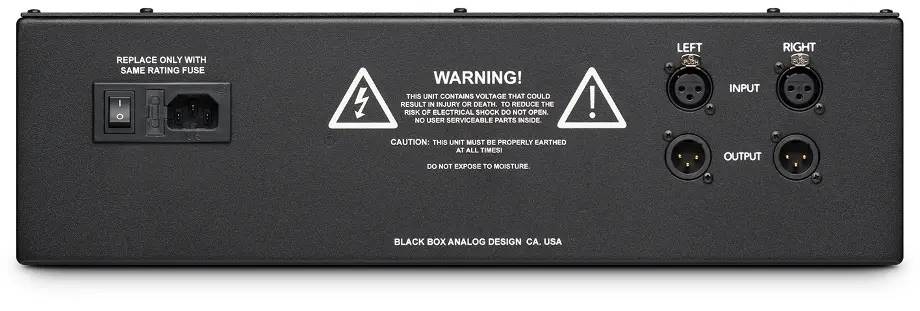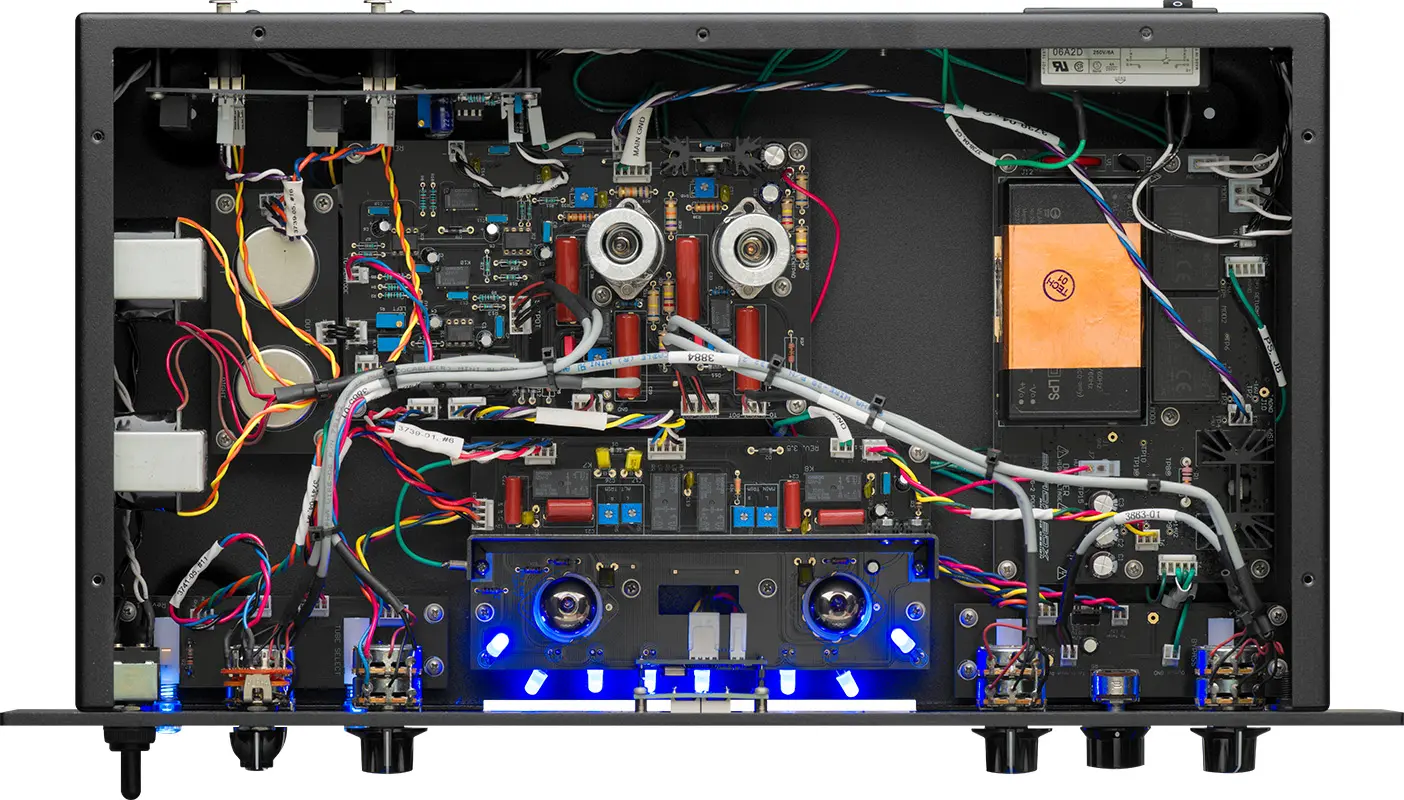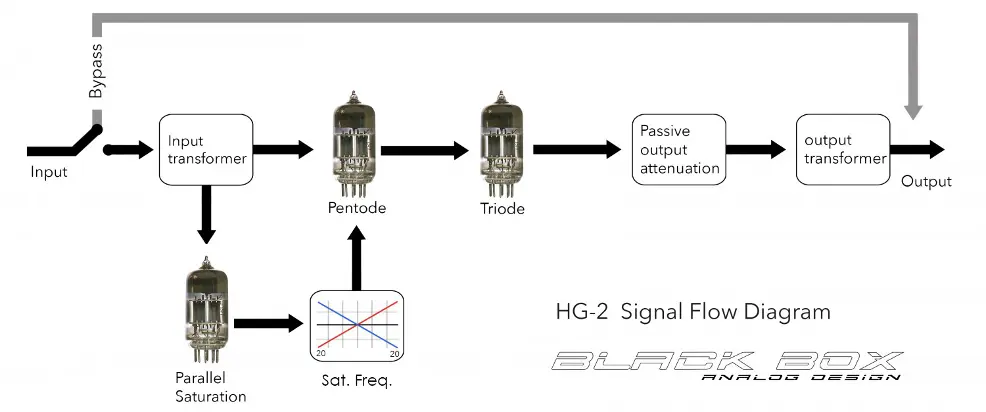
While most things these days are made over seas in huge factories with the singular goal of maximizing profits by cutting corners and using the cheapest components, Black Box Analog Design does things differently.
In fact we take a different approach to most things. We are not interested in creating clones of old gear or building derivatives of popular gear. We are interested in creating gear that does something that hasn’t been done before, addresses a need we come across in the studio and takes a new approach to a problem or design.
We didn’t start out as gear designers. We come from the studio world and years ago, our quest to solve certain problems we came across lead us
to begin tinkering with circuits of our own. Since we came from an audio engineering background and not a circuit design background we weren’t influenced by standard designs or restricted by thoughts of what we “should” do. Instead we allowed our ears to lead us in the right direction.
HG-Q
More than just an incredible EQ
The Black Box Analog Design HG-Q combines unique topology, flexible tube saturation, and the ability to cut and boost simultaneously to create a totally new kind of audio enhancement tool. This dual-mono, stereo, and M/S-capable EQ offers six fully independent and interactive bands for creative frequency shaping and sculpting, combined with acclaimed tube saturation circuitry that adds rich harmonic detail, depth and energy without compromising clarity — taking analog EQ and enhancement to a new level of integration and flexibility. A standout feature is the saturation circuit, which adds rich harmonic content without muddying transients or mix clarity. Unlike conventional saturation, the HG-Q’s circuit brings out lower-level details and enhances the mix's density, resulting in a fuller, more vibrant sound.
Get creative!
HG-Q creates astonishing new possibilities for creativity and workflow. The heart of the HG-Q is a topology where the bands interact with each other in complex ways, allowing the HG-Q to deliver incredible sonic shaping well beyond the scope of traditional equalizers. The 2X mode further expands the EQ’s range, allowing up to 16 dB boosts and cuts with intensified saturation that brings out every harmonic nuance. The result is a more cohesive, balanced, and musically engaging sound, achievable even at aggressive settings. By boosting, cutting, adding saturation, and switching between series and parallel configurations, you will achieve wildly complex interactions and curves impossible on traditional EQs.
True analog processing with plugin control
Seamlessly linked with its included plugin counterpart, the HG-Q plugin delivers digital control over the hardware's true all-analog circuitry. But it doesn't stop there. The HG-Q plugin is not simply a controller; it's also a fully-modeled digital re-creation of the hardware; ideal deal for remote projects where you can't bring your physical HG-Q with you. The plugin even offers functionality beyond that of the hardware: you get a spectrum analyzer and not found on the hardware unit. allowing you to visualize how boosting or cutting on one band affects frequencies far outside its range. An extended control view provides a dedicated knob for each function and control.
Features
Six Independent Bands per channel
Each band provides separate boost and cut circuits with independent gain, Q, and frequency selection controls, allowing for flexible and musical interactions.
Dynamic Phase Interactions
The unique analog topology creates complex phase interactions between bands, enhancing the harmonic relationship of frequencies in a mix. This approach allows for unique types of enhancements to bring out the best in sources.
Tube Saturation
Integrated tube saturation stages within the boost circuits deliver harmonic richness, density and analog character, adding depth and dimension to any audio material.
Solid-State Precision
Solid-state cut filters guarantee clarity and precision when removing problematic frequencies or when compensating for boosts.
2X Mode
Engage 2X mode to double the control range of both boosts and cuts, enabling dramatic tonal reshaping with intensified harmonic saturation.
Flexible Operation Modes
Seamlessly switch between stereo, mid-side (M/S), dual mono, and mono modes to adapt to any workflow or creative requirement. M/S processing opens up new dimensions for stereo imaging and control.
Analog Craftsmanship
Encased in a 3U rack-mount chassis, the HG-Q combines reliability and modern design with classic analog aesthetics. Each unit is built to exacting standards, ensuring durability and performance in demanding studio environments.
Interactive Control
With series and parallel configurations available, the HG-Q offers nuanced and dramatic ways to sculpt your sound, opening up endless possibilities for tonal experimentation and reshaping of sounds and mixes.
Comprehensive Visual Feedback
Intuitive LED indicators and responsive displays provide immediate, actionable insights, streamlining the creative process while maintaining precision.
Hybrid Integration
Seamless communication between hardware and plugin opens up entirely new possibilities and hybrid workflows.
HG-2
MIX BUS, MEET YOUR NEW BEST FRIEND.
The Black Box Analog Design HG-2 is a line level, stereo unit designed to add saturation, harmonics, natural compression, increased RMS and enhancement during mixing and mastering. It is designed to easily and naturally do what usually requires multiple pieces of gear and do it better!
Tubes, transformers & tone!
The HG-2 uses custom input transformers to feed two paths: The main signal path travels through a 6U8A Pentode tube stage that then drives into the Triode stage that follows, resulting in everything from subtle harmonics to full on saturation.
Also fed from the input transformer is a parallel signal path that utilizes a set of 12AT7 tubes, voiced specifically for harmonics and saturation. This parallel saturation circuit is outfitted with a 3 way “Freq. Select” switch that allows the user to choose the frequency content returning from the circuit. The “low position saturates just the low mids and sub frequencies, the “flat” position saturates full bandwidth and the “high” position saturates only the high mids and high frequencies. The result is the ability to add top end to dull tracks, enhance low end or enhance and add energy to the entire signal. The “saturation” knob allows the user to control how much of the processed, parallel signal is fed into the main signal before hitting the Pentode stage. Finally, both stages reach the passive output attenuation before a pair of custom output transformers.
In addition to the saturation stages, an “air” switch adds a subtle top end lift and the “alt” tube button switches between two different 12AT7 tubes in the parallel circuit. Switching between tubes allows the user to select between differently voiced tubes for different types of saturation, instantly.
The meter button switches between 3 modes (VU, VU/Peak & Energy), and the “bypass” switch is a true bypass that shorts the input directly to the output with no additional circuitry in line.
Features:
- High voltage Pentode & Triode tube stages
- Parallel saturation with mix control
- Selectable parallel saturation frequency
- Instantly selectable saturation tubes
- “Air” lift
- Ultra fine L/R trim adjust
- Custom input and output transformers
- True bypass
- Selectable 30 segment meter (3 modes)
- Illuminated push buttons & sealed relays
- Internally modular design for easy servicing






